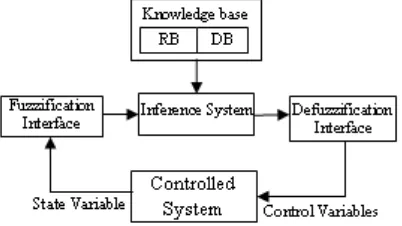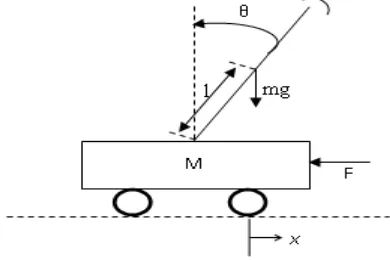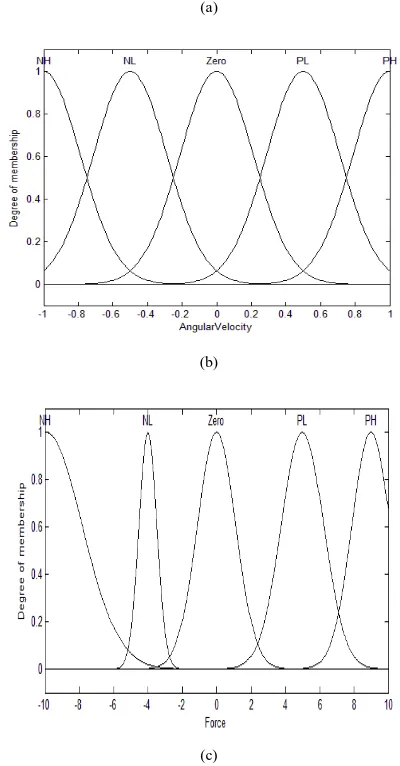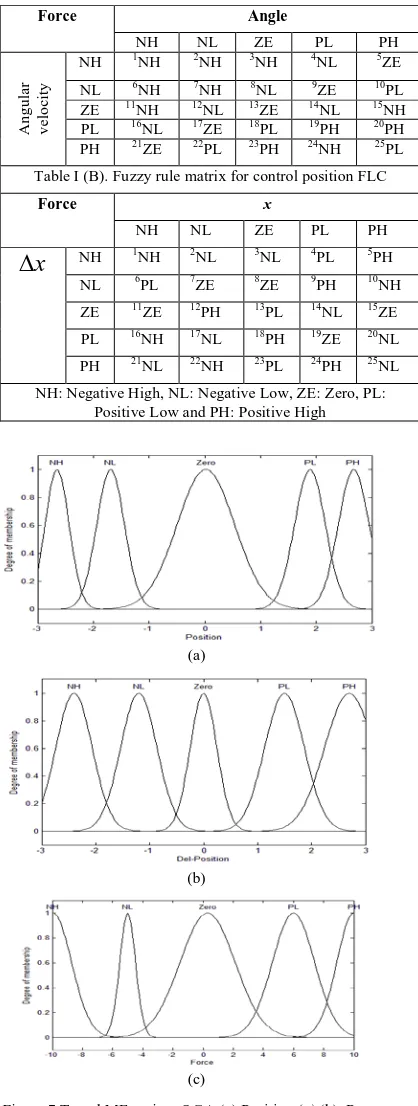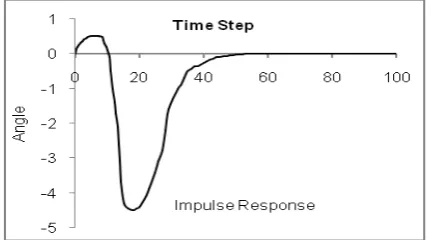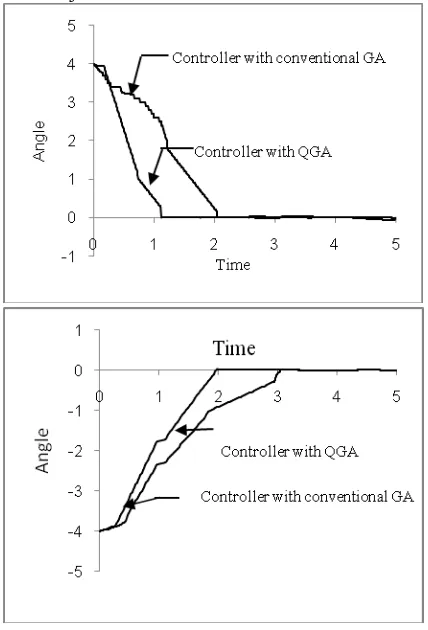Volume 3, No. 7, Nov-Dec 2012
International Journal of Advanced Research in Computer Science
RESEARCH PAPER
Available Online at www.ijarcs.info
ISSN No. 0976-5697
Quantum Fuzzy Controller for Inverted Pendulum System Based on Quantum Genetic
Optimization
Pintu Chandra Shill
Department of System Design Engineering University of Fukui
3-9-1 Bunkyo, Fukui 910-8507, Japan
pintu@synapse.his.u-fukui.ac.jp
Bishnu Sarker
Department of Computer Science and Engineering Khulna University of Engineering and Technology
Khulna-9203, Bangladesh
bishnu_43@yahoo.com
Monalisa Chowdhury Urmi
Department of Electrical and Electronic Engineering Stamford University Bangladesh
Dhaka-1217, Bangladesh
monalisa@stamforduniversity.edu.bd
Kazuyuki Murase*
Department of System Design Engineering
University of Fukui
3-9-1 Bunkyo, Fukui 910-8507, Japan
murase@synapse.his.u-fukui.ac.jp
Abstract: In this paper, we propose a new generalized design methodology of intelligent robust fuzzy control systems based on quantum genetic algorithm (QGA) called quantum fuzzy controller that enhance robustness of fuzzy logic controllers. The QGA is adopted because of their capabilities of directed random search for global optimization to find the parameters of the shape and width of membership functions and rule set of the FLC to obtain the optimal fuzzy controller simultaneously. We test the optimal FLC with modified height defuzzification as a defuzzifier obtained by the quantum computing applied on the control of dynamic balance and motion of cart-pole balancing system. We also present the conventional proportional integral derivative (PID) controller for controlling the linear system of inverted pendulum and determine which control strategy deliver better performance with respect to pendulums angle and carts position. We compare the proposed technique with existing mamdani fuzzy controller which is designed through conventional genetic algorithm and PID controller. Simulation results reveal that QGA based controller performs better than PID controller and conventional GA based controller in terms of running speed and optimizing capability.
Keywords: fuzzy logic controller; quantum computing; optimization; proportional integral derivative (PID) controller; cart-pole balancing problem
I. INTRODUCTION
The concept of Fuzzy Logic was introduced by Professor Lotfi A. Zadeh in 1965[1]. Fuzzy systems have been shown to be effective tools for performing and modeling complex systems. Recently, fuzzy rule-based systems have been applied to pattern classification problems [2], control [3]-[4],prediction [5] and inference [6]. Specifically, they have been used for designing a robust controller that can yield satisfactory performance and deal with uncertainty and imprecision.
There have been a substantial amount of different approaches proposed for a long time to facilitate and automate the design of fuzzy control rules and their associative membership functions shape and width. In the last few years a number of different approaches have been designed for finding optimal fuzzy rule base system using genetic algorithm as a base of the tuning and learning process. Genetic algorithms have demonstrated to be a powerful tool that facilitates the automatic design of fuzzy control rules and their associated membership functions knowledge base.
The purpose of our study is to tune fuzzy rules and their associated membership functions shape and width learning process based on the use of quantum genetic algorithm. Learning cooperative linguistic fuzzy control rules alone are usually not enough for designing an optimal successful fuzzy logic controller since it is difficult to generate optimal fuzzy logic controller. On the other hand, membership functions shape and width of fuzzy control rule also an
important factor for designing an optimal fuzzy logic controller. During the design of fuzzy controller we used modified center of gravity (MCOG) that concerns the information consequent MFs shapes (narrow/wide) and it improves the overall performance of fuzzy control system.
The organization of this paper is as follows. Section 2 present the brief overview of genetic fuzzy system and other related literatures. Section 3 describes the concept relevant to the FLC. Section 4 explains the problem of balancing the inverted pendulum in a greater detail. Section 5 provide the integrated FLC and QGA architecture and also show that how it can be used to solve highly nonlinear dynamic problems. We also introduce the basic principle of QGAs and discuss how they can be used to generate a satisfactory fuzzy rule base and select appropriate shape and width of MFs simultaneously for FLCs. Section 6 presents our simulation results and comparative analysis with existing approaches. Finally, Section 7 provides some concluding remarks and future directions.
II. EVOLUTIONARYFUZZYSYSTEM:BRIEF OVERVIEW
C. karr et al. [7]-[9] use a GA binary encoding chromosome to represent the term sets MFs of all variables in a fuzzy logic rule.Karr uses a binary value to represent three parameters defining a membership value in each term set.
Herrera et. al. [10] proposed a method for tuning fuzzy control rules used by the fuzzy logic control systems. They use a real encoding to represent the four-parameter characterization of a trapezoidal membership value in each term set. Each control rule is defined by the concatenation of the membership values used in the rule premise part and conclusions part. The population is the concatenation of all rules so represented.
More recently, Kim et. al.[11] proposed a method for designing an efficient fuzzy path planner, which satisfy multiple objectives simultaneously, for mobile robot on the basis of quantum inspired evolutionary algorithm. In their work they used a multi-objective quantum inspired evolutionary algorithm to find out optimal fuzzy control rule sets of a fuzzy control system.
III. FUZZYLOGICCONTROLLER
One of the main purposes of using fuzzy logic controller (FLC) originally is to replace human operators in some control task. Fig. 1 shows the basic configuration of FLCs consist of four component elements: Fuzzification interface, a knowledge base, decision-making logic, and a defuzzification interface.
Figure 1. Basic configuration of fuzzy logic controller (FLC)
The first part is the fuzzifier, which converts crisp values, that is actual real world data such as temperature, cost, height etc. into fuzzy sets. Fuzzy inference is the actual process of mapping from a given input to an output using fuzzy logic.
Like most FLCs [1], the FLC discussed here applies the concepts of fuzzy implication and the compositional rules of inference for approximate reasoning. Suppose that we need to design a multiple-input-multiple-output (MIMO) FLC having p inputs x1∈X1,...,xp∈Xp and c outputs consequent MFs associated with the linguistic p input variables and c output variables, respectively, and M is the number of rules in the RB. Lastly, the most frequently used center of gravity (COG) defuzzifier takes output as the COG
of the fuzzy output. The expression generally used for a discrete fuzzy set is as follows:
∑
Whereθjdenotes the center of gravity of the consequent
label Cj of the ruleRj,mo(θj) is the firing strength of this
rule, and p is the number of rules.
Modified height defuzzifier: The modified height defuzzifer was used to handle the consequent uncertainty and improve the FLCs response. The expression generally used for a fuzzy set is as follows:
Whereδkis the spread measure of the kth consequent set.
For Gaussian membership function δkis the standard deviation whereas triangular MF δk is the length of its base.
IV. THECART-POLEBALANCINGPROBLEM
Figure 2. Cart-pole typed inverted pendulumsystem
V. DESIGNOFTSKTYPEFLCUSINGQGA
In this section we introduce the basic principle of quantum genetic algorithm (QGA) and the design process of TSK type-1 FLC using quantum genetic algorithm (QGA). The first step in designing an integrated FLC and QGA, as shown in Fig. 4, is to decide which parts of the KB are subject to be optimized by the QGA.
A. Quantum Genetic Algorithm:
QGA is a probability optimization method which is based on the concept of qubits and superposition of states of quantum mechanics. In a quantum computer the smallest unit of information stored is called a quantum bit or qubit[12] which may be in the ‘1’ state, ‘0’ state or in any super position of the two. Superposition of logical state can be expressed as “α0 +β1 ”. Another way of writing “superposition” is as a vector:
1 0 β
α +
↔
β α
Where α and β are complex number that specify the probability amplitudes of the corresponding states. |α|2 gives the probability that the qubit will be found in “0” state and
|β|2
gives the probability that the qubit will be found in “1”
and they satisfy the normalization condition |α|2+|β|2
= 1. A qubit individual as a string of m Q-bits is defined as:
... ...
2 1
2 1
=
m m q
β β
β
α α
α
Where |αi|2+|βi|2
=1, i = 1, 2, 3…..m.
So a Q-bit individual of m bits can represent states at a time [12].
(a) Chromosome Encoding Schema
(b) Representation of fuzzy set through C and σ
(C) Chromosome Decoding Schema Figure 3. Representation of QGA Chromosome
QGA has a better characteristic of population diversity than others, since it can represent linear superposition of states probabilistically. But higher value of m needs higher computing time of the algorithm. For an optimization problem with fitness function , if we represent each real variable by k bits then the total number of Q-bits in an Q-bit individual m= k×n. So if we apply the evolutionary operators on huge number of bits then they will definitely take a significant amount of time to execute. The QGA uses the power of quantum computation to speed up of genetic procedure. The QGA uses single quantum procedure as an evaluation and selection procedure.
B. Encoding And Decoding/Representation
The most important questions for designing a TSK type-1 FLC using QGA are how to encode the potential solution into chromosome and how to evaluate the potential solution. The chromosomes are coded in a manner that is suitable for using in QGA. Fig. 3 shows a chromosome in QGA coding, decoding, where each chromosome consists of, just a fuzzy rule set and associated membership function.
Evaluate the chromosome: Evaluate the chromosome using the following cost function to be minimized is
∑ + −
= 500=
1( 1 () 2 ( 1))
t p t p F t
J θ
Where p1and p2are weights (
p
1=
1
,
p
2=
0
.
01
).Weused the cost function to evaluate the performance of each fuzzy system defined by the each chromosome of QGA.
Figure 5. Quantum Genetic Tuning Process
the antecedent part of the rules. In this paper we propose the product to measure the degrees of each variable to its corresponding membership functions. The firing strength is then used to shape the output fuzzy set that represents the consequent part of the rule. Therefore, the firing strength of each rule can be defined as:
} ) (
exp{
} ) (
exp{
1
2 2 1
2 2
∑
∏
= =
− −
=
− − =
j
i i
i i j
i i
i i
m x
m x
σ σ φ
C. Quantum Genetic Tuning Process:
In order to design and optimize a fuzzy system QGA can be considered as an optimization tool due to its suitable properties. The automatic knowledge base acquisition can be considered as optimization or search process. In this case quantum genetic algorithm applied for the tuning of database (DB) and/or rule base (RB) of a fuzzy logic controller.
In the proposed integrated architecture (as shown in Fig.4) the overall tuning process works in the following ways (Fig. 5):
Step 1: Design Planning: Identify the variables (inputs, states, outputs) of the cart pole balancing problem. Partition the input and output universe of discourses or the interval spanned by each of the variables into a number of fuzzy regions and assign a fuzzy MF i.e., linguistic label to each region.
Step 2: Initialization: An initial population of candidate solutions is created, generally at random within the domain prescribed by the bounds on variables and each chromosome is encoded into a set of parameter matrix of fuzzy rules and their associated MFs of FLC.
Step 3: Evaluation: Each potential solution (decoded chromosome) is evaluated and assigned a fitness value according to the solving performance of the problem. Sort the individuals according to their fitness values. Check the termination criterion. If satisfied then stops and returns the best fitted chromosome (set of fuzzy rules and shape/width of MF) otherwise go to step 4
Step 4: Recombination: Apply discrete crossover and mutation operator to all chromosomes, to generate new chromosome as well as new generation and go to step 3.
VI. SIMULATIONRESULTSANDCOMPARATIVE
ANALYSIS
In this section, we present the simulation results achieved by employing our proposed approach. We prove the stability of the fuzzy logic controller in time occurs with the tuning fuzzy control rule sets obtained by the proposed approach that we have proposed.
(a)
(b)
(c)
Figure 6. Tuned MFs using QGA (a) Angle (ϴ) (b) Angular Velocity (
∆
θ
) (c) Force F for control angle FLCA. Membership Function:
One of the most important characteristic of fuzzy models is the quantizing of the input and output space of system variables (input, output) into fuzzy regions using fuzzy sets [13]. Dividing the input and output variables into 5 fuzzy sets and appropriate levels are assigned. Figure 6and Fig. 7 show the membership functions for control angle FLC and control position FLC respectively.
B. Fuzzy Control Rules
We have obtained the fuzzy control rules (shown in table I (A) and I (B)) from the best chromosomes of QGA after 100 generations.
C. Control Surface:
Table I (A). Fuzzy rule matrix for control angle FLC
Force Angle
NH NL ZE PL PH
A
ngul
a
r
v
e
lo
c
ity
NH 1NH 2NH 3NH 4NL 5ZE
NL 6NH 7NH 8NL 9ZE 10PL ZE 11NH 12NL 13ZE 14NL 15NH
PL 16NL 17ZE 18PL 19PH 20PH PH 21ZE 22PL 23PH 24NH 25PL
Table I (B). Fuzzy rule matrix for control position FLC
Force x
NH NL ZE PL PH
x
∆
NH 1NH 2NL 3NL 4PL 5PH NL 6PL 7ZE 8ZE 9PH 10NHZE 11ZE 12PH 13PL 14NL 15ZE PL 16NH 17NL 18PH 19ZE 20NL
PH 21NL 22NH 23PL 24PH 25NL NH: Negative High, NL: Negative Low, ZE: Zero, PL:
Positive Low and PH: Positive High
(a)
(b)
(c)
Figure 7.Tuned MFs using QGA (a) Position (x) (b) Rate at which the error of position changes
∆
x
(c) Force F for controlposition FLC
(a)
(b)
Figure 8. Control surface generated by applied FLC for (a) Angle (b) Position
Figure 9. Controller response during switching from swing-up to stabilization
D. Trajectory:
Figure 10. Impulse response for cart’s position
In each generation, all chromosomes are evaluated by the FLC to generate the fitness error. Chromosomes are sorted according to the fitness error and the best one among all chromosomes is selected in each generation. Variation of maximum fitness value versus generation is shown in fig. 11.
Figure 11. Maximum fitness function versus generation
E. Comparative Assessments and Analysis of the
Response:
In this section we presented the proportional integral derivative (PID) controller and Mamdani controller based on conventional GA with five mfs for each input variables and output to the same problem. The QGA based controllers will be compared to the Conventional controller such as PID and GA based fuzzy controllers to see the performance of the controller in order to control an inverted pendulum system. Two tasks are involved in controlling the inverted pendulum system which is the pendulum’s angle and cart’s position. All the results of the controllers will be discussed in this section also.
a. PID Controller: Conventional Controller:
PID is a type of feedback controller whose output, a control variable (CV), is generally based on the error (e) between some user-defined set point (SP) and some measured process variable (PV). Each element of the PID controller refers to a particular action taken on the error. At first, we closely observe the pendulum response using one PID controller. Figure 12 and Fig. 13 shows the pendulum angle and cart position when using single PID controller.
Figure 12. Impulse Response for pendulum Angle when using single PID controller
Figure 13. Impulse Response for cart Position when using single PID controller
From Figure 13, it can be seen that the cart moves in the negative direction with a constant velocity when an impulse force is applied to move it. So although the PID controller stabilizes the angle of the pendulum, this control method would not be feasible to be implemented on an actual physical system that was presented of cart's position and pendulum's angle as the outputs of the system.
Figure 14.Schematic diagram of the inverted pendulum system with two PID controllers
Since one PID controller could not stabilize (Fig. 12 and Fig. 13) both of the angle and the position of the pendulum and the cart, another PID controller is designed to the diagram as shown in Fig. 14. This designed controller used two PID controllers while adaptive controller used two fuzzy logic controllers. In this case, one PID controller used to control the pendulum angle and another PID controller used to control the pendulum position. The output responses of the system (angle and position) are shown in Fig. 15 and Fig. 16 respectively. We have shown that by using this double coupled PID controller approach, the system is successfully stabilized and all of the characteristics for the both responses of the system are met design criteria satisfactorily.
Figure 15. Impulse response for pendulum angle when using two PID controllers
PID2
Figure 16. Impulse response for cart’s position when using two PID controllers
From both (Angle and position) of impulse response characteristics, it can be stated that the fuzzy controller with quantum GA has the ability to response and stabilize quickly compared to conventional PID controller. The response obviously has more robustness than the PID controller.
On the other hand, it was found that the PID controller is a good controller to control the single-input-single-output (SISO) system. However, the PID alone cannot be used successfully to control the cart's pendulum and pendulum's angle simultaneously.
b. Mamdani Controller with conventional GA:
We also analyse the performance of quantum GA based fuzzy controller against the Mamdani controller with conventional GA.The fuzzy logic control with quantum GA happens to be more robust and reliable than the fuzzy logic control with conventional GA in successfully swinging the pendulum to the stabilizing position. From Fig. 17 it is obvious that the performances of FLC with QGA are better than those in FLC with conventional GA. It not only takes less time to reach the stabilize position, but also it shows the smoother trajectories.
Figure 17. Controller Response Comparison between FLC controller through Conventional GA and QGA
c. Evaluating our work with adaptive approach:
The inverted pendulum is a classical and contemporary open loop control problem. It is an inherently open loop unstable with highly non-linear dynamics and an under actuated mechanical system and used as a well-known test bed for the evaluation of new control algorithms. The control system for cart-pole inverted system is stabilized within a few seconds or time steps in several studies including [14]-[15]. The closer inspection of the study in
[14] reveals that the system is stabilized within 46 time steps for the best case and 4461 for the worst cases from initial pole angles ±150 degrees and random cart positions ±2.4 meters. For the same initial condition, the number of time steps required to stabilize the cart-pole system is 33 for best case and 3123 is for the worst case while using our proposed approach. The time steps required for cart and pole stabilization were computed over 20 simulations for each method.
In order to evaluate our new QGA-based approach, we compare it against well-known reinforcement learning method called SANE (Symbiotic, Adaptive Neuro-Evolution)[14]. SANE is evolutionary neural networks based cooperative model that has been applied to cart pole type inverted pendulum system with very promising results [14]. SANE algorithm works on the basis of group interaction-based evolutionary algorithm for improving the symbiotic GA. The group interaction based evolutionary algorithm is developed from a symbiotic evolution. In SANE each chromosome refers to a single neuron, and the neural networks formed are the results of the evolution of a population of these chromosomes through co-evolution and speciation.
VII. CONCLUSIONS
In this paper we have presented a new design method based on QGA for designing an optimal fuzzy controller to control real time cart pole inverted pendulum system for stabilization. The proposed architecture is able to tune comprehensible and reliable fuzzy rules and their optimal membership functions by a QGA learning adaptive method. Several experiments were conducted to verify the robustness of the fuzzy controller under several initial conditions. Based on these experiments, we have found that the proposed approach was robust and significantly better than fuzzy control system through conventional GA, SANE and conventional PID controller. The Simulation results show the proposed technique find an optimal or near optimal fuzzy control system.
Suggestions for follow-up works that may come after this study are as follows: The research work is to be extended by embedding rules reduction technique in the proposed control architecture. In this case statistical least square method is used to determine the importance order of rules and cut the unimportant rules. This study also extended through the parallel implementation of the proposed algorithm that may be used to improve the convergence speed of the proposed method. Finally, although the controllers has been successfully stabilized the system, implementation of the algorithm into more complex real application is very important. Since FLC could stabilize the nonlinear system, it is expected that the FLC will work well if it is implemented into more complex real system.
VIII. REFERENCES
[1]. L. A. Zadeh ,”Outline of a new approach to the analysis of complex systems and decision processes,” IEEE Trans. Syst.,Man.,Cyben.,vol SMC-3, pp. 28-44, jan. 1973.
[3]. Y. F. Li and C. C. Lan," Development of fuzzy algorithms for servo systems," IEEE Contr. Syst. Mag., vol. 9, no. 3, pp. 65-73,1989.
[4]. W. Pedrycz, Fuzzy Control and Fuzzy Systems, New
York: J. Wiley, 1989.
[5]. C. H. Lee and C. C. Teng, “Identification and control of dynamic systems using recurrent fuzzy neural networks,” IEEE Trans. Fuzzy Syst., vol. 8, no. 4, pp. 349-366, Aug. 2000.
[6]. T. Yamakawa an
relationship network as knowledge acquisition tool and fuzzy inference engine,” in proc. IEEE world conf. Comput. Intell.,2008pp. 159-180.
[7]. C.L. Karr. “Design of an adaptive fuzzy logic controller using genetic algorithms,” in proc. Int. Conf. on Genetic Algorithms (ICGA'91), San Diego, CA., USA, 1991, pp. 450-456.
[8]. C.L. Karr,“Genetic algorithms for fuzzy controllers,”AI Expert, vol. 6, no. 2, pp. 27-33, 1991.
[9]. C.L. Karr,“Fuzzy control of ph using genetic
algorithms,”IEEE Trans. on Fuzzy Systems, pp. 46-53, 1993.
[10]. F. Herrera, M. Lozano, and J.L. Verdegay, "Tuning fuzzy logic controllers by genetic algorithms,"presented at Int. J. Approx. Reasoning,1995,pp.299-315.
[11]. Ye-Hoon Kim and Jong-Hwan Kim, “Multiobjective
Quantum-inspired Evolutionary Algorithm for Fuzzy Path Planning of Mobile Robot”, in proc. IEEE Congress on Evolutionary Computation, 2009, pp.1185-1192 .
[12]. T. Hey, ”Quantum computing: an introduction,”
Computing & Control Engineering Journal, pp. 105-112, Jun. 1999.
[13]. T. Koga, K. Horio, and T. Yamakawa, “Self-organizing
Relationship (SOR) Network with fuzzy Inference Based Evaluation and Its application to Trailer-Truck Back-up control,” in proc. of 11th Int. Con. on Neural Information Processing(ICONIP), 2004, pp. 368-374.
[14]. D. E. Moriarty and R. Miikkulainen, “Efficient
Reinforcement Learning Through Symbiotic Evolution,” Machine Learning, vol. 22, pp. 11–32, 1996.
[15]. F. H. L. H. K. Lam and P. K. S. Tam, “Design and Stability Analysis of Fuzzy Model-Based Nonlinear Systems Using Genetic Algorithm,” IEEE Trans. Systems, Man and Cybernetics, vol. 33, no. 2, pp. 250–257, 2003.
[16]. P.C. Chen, C.W. Chen, and W.L. Chiang, “GA-based
modified adaptive fuzzy sliding mode controller for nonlinear systems,” Expert Systems with Applications, vol.36, pp. 5872–5879, 2009.
[17]. R. Jain, N. Sivakumaran, and T.K. Radhakrishnan, “Design of self tuning fuzzy controllers for nonlinear systems,” Expert Systems with Applications, vol.38, pp. 4466–4476, 2011.
[18]. R.-E. Precup, R.-C.David, E.M. Petriu, S. Preitl, and
M.-B.Rădac, “Fuzzy control systems with reduced parametric
sensitivity based on simulated annealing,” IEEE Trans. Industrial Electronics, vol. 99, pp. 1-15, 2011.
[19]. G.-R. Yu, Y.-J.Huang, and L.-W. Huang, “T-S fuzzy
control for magnetic levitation systems using quantum particle swarm optimization,” in Proc. SICE Annual Conference, 2010, Taipei, Taiwan, pp. 48–53.
[20]. J.M. Mendel,“Rule-Based Fuzzy Logic Systems:
Introduction and New Directions,” Prentice-Hall, Englewood Cliffs, NJ, 2001.
[21]. F. Bolata and A. Nowr, “From fuzzy linguistic
specifications to fuzzy controllers using evolution strategies,”in Proc. 4th IEEE Internat.Conf. on Fuzzy Systems, Yokohama, 1995, pp.1089-1094.
[22]. Panchi Li, Kaoping Song, and Erlong Yang, “Quantum genetic algorithm and its application to designing fuzzy neural controller,” in proc. Int conf. on Natural Computation, 2010,pp. 2994 – 2998.
[23]. H. Surmann, A. Kanstein and K. Goser “Self-organizing
and genetic algorithms for an automatic design of fuzzy control and decision systems,” in proc. 1st European Congress on Fuzzy and Intelligent Technologies, 1993, Aachen, pp. 1097-1104.
[24].
Fuzzy LS-SVM Integrated Quantum Genetic Algorithm” Journal of pp. 1365-1371, 2010.
[25]. J. Mendel, “Uncertain Rule-Based Fuzzy Logic Systems:
Introduction and New Directions,” Upper Saddle River, NJ: Prentice-Hall, 2001.
[26]. M. Mohammadian and R. J. Stonier, “Fuzzy logic and
genetic algorithms for intelligent control and obstacle avoidance,” in Complex Systems: Mechanism of Adaptation, R. J. Stonier and X. H. Yu, Eds. Amsterdam: IOS Press, 1994, pp. 149-156.
[27]. L. X. Wang, “Adaptive Fuzzy systems and control: Design and Stability Analysis,” PTR Prentice-Hall, Englewood cliffs, NJ. 1994.
